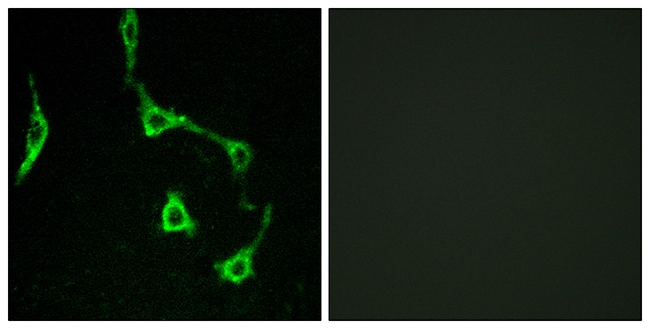
ICC/IF analysis of LOVO cells using GTX87749 Cadherin 10 antibody. The picture on the right is blocked with the synthesized peptide.
Cadherin 10 antibody
GTX87749
ApplicationsImmunoFluorescence, ImmunoCytoChemistry
Product group Antibodies
TargetCDH10
Overview
- SupplierGeneTex
- Product NameCadherin 10 antibody
- Delivery Days Customer9
- Application Supplier NoteICC/IF: 1:100~1:500. *Optimal dilutions/concentrations should be determined by the researcher.Not tested in other applications.
- ApplicationsImmunoFluorescence, ImmunoCytoChemistry
- CertificationResearch Use Only
- ClonalityPolyclonal
- ConjugateUnconjugated
- Gene ID1008
- Target nameCDH10
- Target descriptioncadherin 10
- Target synonymscadherin-10, T2-cadherin, cadherin 10 type 2
- HostRabbit
- IsotypeIgG
- Protein IDQ9Y6N8
- Protein NameCadherin-10
- Scientific DescriptionThis gene encodes a type II classical cadherin of the cadherin superfamily. Alternative splicing of this gene results in multiple transcript variants. At least one of these variants encodes a preproprotein that is proteolytically processed to generate the mature cadherin protein. These integral membrane proteins mediate calcium-dependent cell-cell adhesion and are composed of a large N-terminal extracellular domain, a single membrane-spanning domain, and a small, highly conserved C-terminal cytoplasmic domain. The extracellular domain consists of 5 subdomains, each containing a cadherin motif, and appears to determine the specificity of the proteins homophilic cell adhesion activity. Type II (atypical) cadherins are defined based on their lack of a histidine-alanine-valine (HAV) cell adhesion recognition sequence specific to type I cadherins. This particular cadherin is predominantly expressed in brain and is putatively involved in synaptic adhesions, axon outgrowth and guidance. Mutations in this gene may be associated with lung squamous cell carcinoma and colorectal cancer in human patients. [provided by RefSeq, Nov 2015]
- Storage Instruction-20°C or -80°C,2°C to 8°C
- UNSPSC12352203





